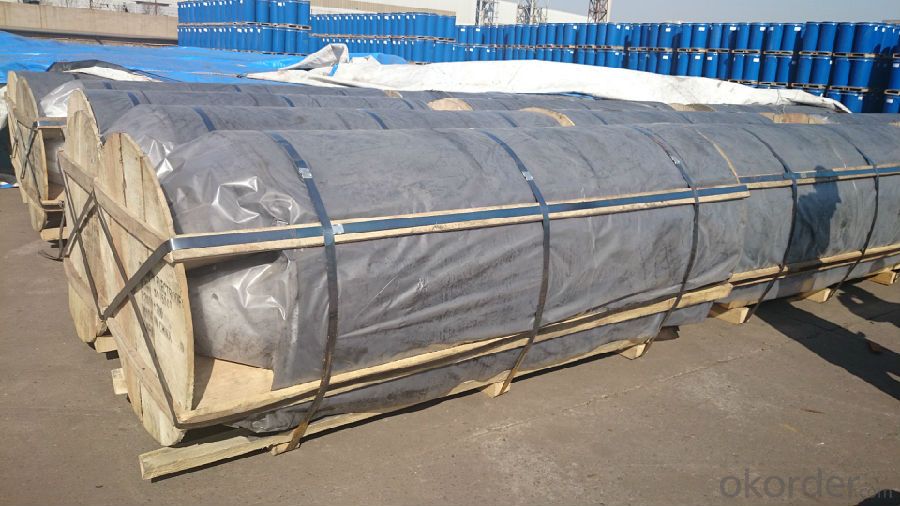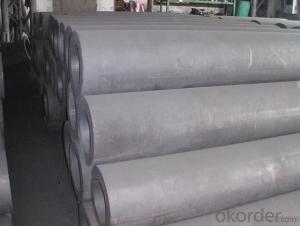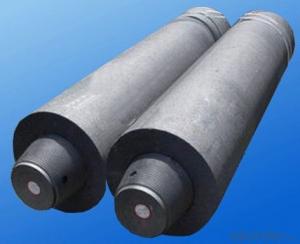Carbon Electrodes With Very Stable Quality
- Loading Port:
- Lianyungang
- Payment Terms:
- TT OR LC
- Min Order Qty:
- 20 m.t.
- Supply Capability:
- 700 m.t./month
OKorder Service Pledge
OKorder Financial Service
You Might Also Like
Carbon Electrodes With Very Stable Quality
Features
1:carbon eletrode
2:for ferroalloy,calcium carbide, silicon metal, manufacture
Graphite/Carbon Electrode Paste Specification
| PARAMETER UNIT GUARANTEE VALUE | ||||||
| Items | Φ500~Φ700 | Φ750~Φ960 | Φ1020~Φ1400 | |||
| Rs μΩ.m | ≤45 | ≤38 | ≤45 | ≤38 | ≤40 | |
| Bulk Desity g/cm3 | ≥1.55 | ≥1.58 | ≥1.55 | ≥1.58 | ≥1.55 | ≥1.58 |
| Bending Strength MPa | 3.5~7.5 | 4.0~7.5 | 3.5~7.5 | 4.0~7.5 | 3.5~7.5 | 4.0~7.5 |
| Compressive Strength MPa | ≥20.0 | ≥20.0 | ≥20.0 | ≥20.0 | ≥19.0 | ≥19.0 |
| Compressive Strength MPa | 3.2~4.8 | 3.0~4.6 | 3.2~4.8 | 3.0~4.6 | 3.2~4.8 | 3.0~4.6 |
| Ash % | ≤2.5 | ≤2.0 | ≤2.5 | ≤2.0 | ≤2.5 | ≤2.0 |
Pictures:

We can adjust the size based on different enquiry. please contact us if you are interested in this materials, we will send our offer as soon as get your kind email.
Do you know the use of the graphite electrode?
1, It is used for the electric arc furnace steel making. (About 70-80% graphite electrode is used for steel making).
2, It is used for the submerged arc furnace, including melting iron alloy, pure silicon, yellow phosphorus,
matte, calcium carbide and so on.
3, It is used for the resistance furnace, such as the graphite making, melting glass, silicon carbide
making and so on.
- Q:How does carbon affect the water cycle?
- Carbon affects the water cycle primarily through the process of photosynthesis, where plants and algae absorb carbon dioxide from the atmosphere and release oxygen. This process not only regulates the carbon dioxide levels in the atmosphere, but also influences the temperature and precipitation patterns, subsequently impacting the water cycle. Additionally, carbon dioxide dissolves in water, forming carbonic acid, which can alter the pH levels of water bodies and potentially affect aquatic life and the overall balance of the water cycle.
- Q:What is the importance of carbon dating in archaeology?
- Carbon dating is crucial in archaeology as it allows us to determine the age of artifacts and remains with remarkable accuracy. By analyzing the levels of carbon-14 isotopes in organic materials, we can establish when they were last alive or in use. This information provides valuable insights into the chronology of human history, enabling archaeologists to reconstruct past civilizations, understand cultural changes, and refine our understanding of the past.
- Q:How is carbon used in the production of carbon fiber?
- Carbon is used in the production of carbon fiber by being subjected to high temperatures and combined with other elements to create a material that is strong, lightweight, and resistant to heat and chemicals.
- Q:What should we do to reduce carbon emissions in our lives?
- Reducing the burning of fossil fuels is important, reducing the emission of motor vehicles, reducing private cars, reducing thermal power, and burning carbon emissions from coal-fired power plants
- Q:What is the carbon footprint?
- The carbon footprint is a measure of the total greenhouse gases, specifically carbon dioxide (CO2), that are released into the atmosphere due to human activities. It quantifies the impact individuals, organizations, or countries have on the environment by contributing to climate change. This impact encompasses both direct emissions from burning fossil fuels for transportation, heating, and electricity, as well as indirect emissions from the production and transportation of goods and services we consume. Measured in units of carbon dioxide equivalent (CO2e), the carbon footprint serves as a vital tool for assessing and managing our environmental influence. By comprehending and diminishing our carbon footprint, we can alleviate climate change and strive for a more sustainable future.
- Q:How does carbon impact food production?
- Carbon impacts food production in several ways. Firstly, carbon dioxide (CO2) is a crucial component for photosynthesis, the process through which plants convert sunlight into energy. Increased levels of atmospheric CO2 can enhance plant growth and crop yields. However, excessive carbon emissions from human activities, such as burning fossil fuels, contribute to the greenhouse effect, leading to climate change. Climate change affects food production by altering temperature and rainfall patterns, increasing the frequency and intensity of extreme weather events like droughts, floods, and storms. These changes disrupt agricultural systems, decrease crop productivity, and threaten food security. Additionally, carbon emissions contribute to air pollution, which can harm crop health and reduce yields. Therefore, managing carbon emissions and mitigating climate change are crucial for sustainable and resilient food production.
- Q:How does carbon impact the growth and development of plants?
- Carbon is an essential element for the growth and development of plants. It plays a crucial role in the process of photosynthesis, which is how plants convert sunlight into energy. During photosynthesis, plants absorb carbon dioxide from the atmosphere and use it, along with water, to produce glucose and oxygen. Glucose is the primary source of energy for plant growth and is utilized to build various molecules such as cellulose, proteins, and lipids. In addition to being a key component of sugars, carbon is also a vital element in the structure of plant cells. It forms the backbone of complex organic compounds, including carbohydrates, proteins, nucleic acids, and lipids. These compounds are essential for the growth and development of plants, as they are involved in processes like cell division, cell elongation, and the formation of new tissues. Furthermore, carbon is involved in regulating various physiological and metabolic processes in plants. It influences the opening and closing of stomata, the tiny pores on the surface of leaves, which control the uptake of carbon dioxide and the release of oxygen and water vapor. Carbon also affects the production of plant hormones, which are responsible for regulating growth, development, and responses to environmental stimuli. However, excessive carbon dioxide in the atmosphere, resulting from human activities such as burning fossil fuels, can have negative impacts on plants. Elevated levels of carbon dioxide can lead to changes in plant physiology, including increased photosynthesis rates and decreased stomatal conductance. These changes can affect the nutritional quality of plants, alter their interactions with pests and diseases, and disrupt ecosystems. In summary, carbon is essential for the growth and development of plants as it is a key component of sugars, organic compounds, and structural elements in plant cells. It is involved in processes such as photosynthesis, cell division, and the regulation of physiological and metabolic functions. However, changes in atmospheric carbon dioxide levels can have both positive and negative impacts on plants, emphasizing the need for sustainable practices to ensure the future growth and development of plant species.
- Q:What are the carbon monoxide collection methods?
- Carbon monoxide can only be collected by drainage. Carbon monoxide is insoluble in water, carbon monoxide is poisonous, and the density is very close to that of the air, so it can not be collected with exhaust air. It can only be drained. Here are some gas collection methods and the types of gases they target:Downward exhaust air: H2Upward air method: CO2, O2, SO2Drainage: H2, COWater insoluble gases can be drained by gas collectionThe density is not large and does not react with the gas in the air. It can be used for the upper airA gas that is smaller than air and does not react with gas in the air can be used to exhaust air (e.g., H2)As long as the relative molecular mass of the gas is greater than 29, the density is basically larger than that of the air
- Q:What do you stand for?Tar, smoke, nicotine, and carbon monoxide. What do you mean? What's the size of the smoke, or the size of the smoke? What's the connection? Smoking is harmful, so how do you choose to smoke smaller cigarettes?
- Compared with the 1mg now, but the taste of light to you simply don't get things, unable to meet the physiological needs, will be more big. So the deep harm than simple 5mg smoke into the lungs and then exhale.Just feel well enough on the line. This was something very mysterious, you can go to a professional ask smoking community. Um. Provide a product Baidu search on it. Is a product tasting tea smoke forum.
- Q:What is the carbon content of 45# steel?
- The main component of 45# steel is Fe (Tie Yuansu), and contains the following elements:C:0.42~0.50%Si:0.17~0.37%Mn:0.50~0.80%P: = 0.035%S: = 0.035%Cr: = 0.25%Ni: = 0.25%Cu: = 0.25%Density 7.85g/cm3, elastic modulus 210GPa, Poisson's ratio 0.269.
1. Manufacturer Overview |
|
|---|---|
| Location | |
| Year Established | |
| Annual Output Value | |
| Main Markets | |
| Company Certifications | |
2. Manufacturer Certificates |
|
|---|---|
| a) Certification Name | |
| Range | |
| Reference | |
| Validity Period | |
3. Manufacturer Capability |
|
|---|---|
| a)Trade Capacity | |
| Nearest Port | |
| Export Percentage | |
| No.of Employees in Trade Department | |
| Language Spoken: | |
| b)Factory Information | |
| Factory Size: | |
| No. of Production Lines | |
| Contract Manufacturing | |
| Product Price Range | |
Send your message to us
Carbon Electrodes With Very Stable Quality
- Loading Port:
- Lianyungang
- Payment Terms:
- TT OR LC
- Min Order Qty:
- 20 m.t.
- Supply Capability:
- 700 m.t./month
OKorder Service Pledge
OKorder Financial Service
Similar products
New products
Hot products
Related keywords































